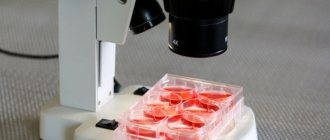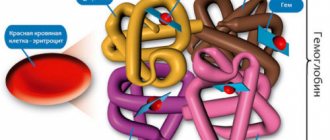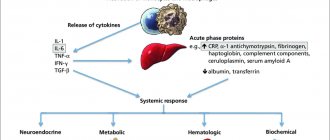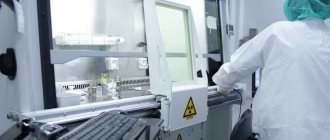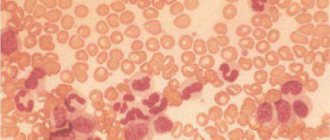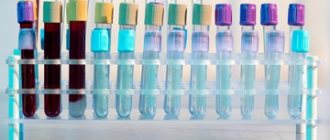Seromucoids (seroglycoids) in the blood: norms, reasons for increase and decrease
© Z. Nelly Vladimirovna, laboratory diagnostics doctor at the Research Institute of Transfusiology and Medical Biotechnology, especially for SosudInfo.ru (about the authors)
Seromucoids or seroglycoids are serum glycoproteins (complex proteins containing carbohydrates). Proteins and carbohydrates in the fraction of carbohydrate-protein complexes are in a ratio of 1:12, that is, for 1 part of all plasma proteins there are several groups of all carbohydrates present in the plasma, which consist of the same or different monosaccharide residues (heterooligosaccharides).
The main habitat of these glycoproteins is connective tissue, where they are concentrated in large quantities.
However, if the connective tissue is subjected to mechanical stress or change and destruction for other reasons, then seroglycoids leave their usual conditions and are directed into the bloodstream (in such cases, seromucoids in the blood are increased).
This circumstance long ago formed the basis for one of the biochemical tests (seromucoid in the blood), which, however, is gradually increasingly joining the category of outdated laboratory tests.
Meanwhile, diagnostic laboratories located in the “outback”, not fully equipped with advanced technologies, and therefore not having the opportunity to use the latest techniques, use the old-fashioned test for seromucoid to diagnose inflammatory processes of any localization. And, it should be noted, very successfully.
Norm of seromucoids in blood and purpose of analysis
The norm of seromucoid in the blood for women and men is the same; in children, by the way, it also does not differ in its values, so we can say that the norm for the concentration of carbohydrate-protein complexes in the blood plasma does not depend on gender and age.
Normal values may be expressed in different units, in addition, the upper and lower limits may not coincide according to data from different sources (determined in accordance with the reference values accepted in a particular laboratory).
Thus, the reader may encounter the following variants of the norm:
- 1.2 – 1.6 mmol/l;
- 0.22 – 0.28 g/l
- 0.16 – 0.20 units.
The close connection of the complex protein carrying the carbohydrate component with any inflammatory processes is explained by the fact that it consists of several individual “acute phase” proteins (the fraction of carbohydrate-protein complexes contains at least eight “acute phase” proteins). It can be:
- Alpha1-acid glycoprotein (orosomucoid);
- Alpha1-antitrypsin;
- Alpha2-glycoprotein;
- Haptoglobin;
- ZAG (Zinc alpha2 glycoprotein);
- Fetuin-A (alpha-fetoprotein);
- Erythropoietin;
- Chorionic gonadotropin:
In connection with the above, this analysis can, to a greater or lesser extent, clarify the situation if any inflammatory reactions are suspected (acute and sluggish processes without clear clinical symptoms - here this test is most useful) or conditions accompanied by cell destruction and the release of seromucoid into the blood.
The pathological (inflammatory and necrobiotic) process that occurs with the destruction of cells creates conditions for the release of carbohydrate-protein complexes into the blood and an increase in their concentration in the serum.
It is not physiologically occurring events that force the body to respond by increasing the content of “acute-phase” proteins and other biochemical indicators. Thus, seromucoids are elevated primarily in the following pathological conditions:
- Exacerbation of chronic inflammatory diseases;
- Malignant neoplasms, including after treatment of a neoplastic process (radiotherapy, radiation exposure, cytostatics, hormones) for the purpose of prognosis (an indicator that has returned to normal indicates a positive effect from the treatment measures received);
- Diseases of the lower respiratory tract (pneumonia, primary pulmonary hypertension, pleurisy, bronchitis, bronchial asthma);
- Tuberculosis process localized in the lungs, in order to predict the outcome of the disease (the higher the concentration, the worse the prognosis);
- Necrosis of the heart muscle (myocardial infarction);
- Diabetes mellitus;
- Certain renal pathologies (glomerulonephritis);
- Rheumatoid arthritis;
- Systemic lupus erythematosus (SLE);
- Gout;
- Exacerbation of chronic calculous cholecystitis (cholelithiasis);
- Inflammation of the pancreas (pancreatitis);
- Jaundice syndrome, especially caused by the development of a tumor process;
- Acute cerebrovascular accident (cerebral infarction);
- Diseases of the thyroid gland when considering its surgical removal.
However, in the human body it is possible not only to increase the concentration of glycoproteins of a given fraction; there is also a reverse reaction. A decrease in seromucoid levels is observed in patients suffering from diseases that impair the production of carbohydrate-protein complexes in the liver. These include:
- Infectious hepatitis;
- Liver cirrhosis of any origin;
- Hepatocellular dystrophy (Konovalov-Wilson disease);
- Multiple sclerosis;
- Some endocrine diseases.
Most often, determination of the level of seromucoid in the blood, along with other biochemical markers of inflammatory and necrobiotic processes (total protein, protein fractions, sialic acids, CRP - C-reactive protein, RF - rheumatoid factor, haptoglobin) is “ordered” by therapists, cardiologists, rheumatologists, pulmonologists and phthisiatricians. As a rule, the study of the content of this indicator is not carried out in isolation, but goes along with the listed laboratory tests.
© 2012-2020 sosudinfo.ru
Sources
Display all posts with the tag:
Source: https://sosudinfo.ru/krov/seromukoidy/
Indications
Indications for testing for seromucoids vary. Most often, this study is carried out to monitor the development of tuberculosis of the lungs, including in children. If the indicators are significantly increased, then this is a sign of low effectiveness of treatment.
In addition, the analysis is carried out when monitoring the condition of patients (adult men and women, children), during the therapeutic treatment of malignant tumors. If, after taking cytotoxic drugs, hormonal drugs or using radiotherapeutic methods, the normal level of seromucoids in the blood plasma is maintained, then the prognosis for treatment is favorable.
Seromucoids are often studied in rheumatology; analysis is especially informative when examining children. In addition, such an analysis is necessary to resolve the issue of the need to remove the thyroid gland in case of organ pathology.
Another indication for testing is chronic inflammatory diseases. When examining pregnant women, an increase in the content of seromucoids in the last trimester is a marker of the inflammatory process, even in the absence of external manifestations.
Seromucoids: what is it, is it normal in the blood, what to do if their level is elevated?
Seromucoid is a complex protein that is found in large quantities in loose and dense connective tissues and can be present in blood plasma.
When connective tissue is destroyed, damaged or degraded, the number of these proteins in the plasma increases sharply. This fact underlies a biochemical blood test to determine their quantity.
Data on an increased concentration of proteins in the blood indicate the presence of an inflammatory process or other developing pathology in the body.
Role in the body
Seromucoids (seroglycoids) are a fraction of blood plasma proteins from the group of serum glycoproteins.
They contain carbohydrate components, they have acidic properties and are able to dissolve in acid.
They take part in the regulation of protein metabolism and the construction of connective tissue; without their participation, the life of the body is impossible.
Why get tested and how is it done?
The assumption of inflammation or damage to the connective tissue is an indication for a blood test to determine the number of seromucoids.
Main indications for the study:
- rheumatism (external manifestations - the presence of a crunch when rotating a joint, pain when stretching a limb, clicking when walking);
- inflammatory process (in acute or chronic stage);
- monitoring the body’s condition after cancer therapy;
- surgery to remove the thyroid gland or trauma to it.
To diagnose the number of seromucoids, the patient needs to donate blood from a vein. The study of this indicator is not carried out in isolation, but is carried out in combination with other laboratory tests (total protein, protein fractions, rheumatoid factor, etc.). This test can be taken at any municipal or private clinic.
Recommendations for obtaining reliable results:
- Blood should be donated in the morning and on an empty stomach; you are only allowed to drink clean water.
- 24 hours before the test, you must avoid taking medications, alcohol, and 12 hours before smoking cigarettes. In a situation in which it is impossible to stop taking medications, you should consult a doctor.
- On the eve of the test, physical and emotional stress should be avoided.
- Women should consult a doctor first. When carrying out the procedure, the day of the patient's menstrual cycle should be taken into account.
- You should not take the test immediately after undergoing diagnostic procedures, such as fluorography, x-rays.
The results of the analysis are determined using a method called turbodimetric. The essence of the method is that the serum particles of the substance absorb light in different ways. Measurements are made using a spectrophotometer.
Normal blood levels
Seromucoids are always present in a certain concentration in human blood; neither the age nor the gender of the patient matters.
The norm varies from 0.13 to 0.2 optical plane units or from 1.2 to 1.6 mmol/l. The rate will be the same for men, women and even children.
The patient's blood type also does not affect its value in any way.
If a laboratory test reveals a borderline value of the indicator, then a repeat control diagnosis is prescribed after 1-2 weeks.
What to do if the level is different from the norm?
Often, patients show not only an increase in the level of seromucoids, but also, on the contrary, a decrease in it. The nature of deviations from the norm will depend on the underlying cause.
Accordingly, the prescribed treatment will also depend on the type of pathology detected.
Promoted
If the level of seromucoids is elevated, this means that inflammatory and necrobiotic processes are present in the body.
These processes contribute to the release of carbohydrate-protein complexes into the blood and lead to an increase in their number in the serum.
Thus, if a patient has elevated seromucoids, this may indicate the presence of diseases such as:
- necrosis of the heart muscle (myocardial infarction);
- destructive form of pulmonary tuberculosis;
- icteric syndrome in newborns;
- joint diseases (rheumatism, rheumatoid arthritis, etc.);
- malignant neoplasms (tumors);
- pancreatitis (increased alpha-amylase concentration);
- diseases of the lower respiratory tract (pneumonia, asthma, bronchitis);
- violation of purine metabolism (gout);
- certain renal pathology (glomerulonephritis);
- acute circulatory disturbance in the vessels of the brain (ischemia).
A high level of protein fraction is a marker that autoimmune diseases are developing in the body. In this case, the immune system produces special protein molecules - antibodies.
As a result of a malfunction, these molecules enter into a fight not with viruses and bacteria, but with their own cells. The more cells that are damaged, the higher the level of antibodies and the stronger the subsequent attack from the body.
Chronic pathological processes against the background of calcium metabolism disorders and iron deficiency in the blood can lead to the development of anemia.
Demoted
If the level of seromucoids is reduced, then most often this is due to diseases that disrupt the production of carbohydrate-protein complexes in the liver, such as:
- hepatitis;
- cirrhosis;
- hepatocellular dystrophy (Wilson-Konovalov disease);
- multiple sclerosis;
- some diseases of the pancreas.
The activity of synthesis processes in the liver can be assessed by the level of cholesterol in the blood. In case of severe liver damage, the analysis will show a significant drop in its level in the blood serum.
Prevention
Deviation of the number of seromucoids from the normal value is not an independent disease, so prevention in this case is not required. In order to normalize their level, it is necessary to identify the cause of the disease and receive comprehensive treatment.
As a rule, after effective therapy, everything returns to normal and the only way for further prevention is a healthy lifestyle, timely vaccination, regular medical examinations, compliance with personal hygiene rules, and avoiding contact with sick people.
Dmitrieva Yulia (Sych) – In 2014, she graduated with honors from Saratov State Medical University named after V. I. Razumovsky. Currently working as a cardiologist at the 8th City Clinical Hospital in the 1st clinic.
Source: https://infoserdce.com/krov/seromukoidy/
Normal indicators and deviations
In different laboratories, the norm of biochemical blood parameters may differ slightly due to the use of different reagents. Therefore, you need to pay attention to the values indicated in the “norm” column in the laboratory form.
When using the most common research method, the norm for seromucoid content for children and adult men and women is 3-5 U/l.
If the indicators are higher
If the indicators are elevated, this indicates the presence of an inflammatory process that destroys connective tissue. In adult men and women, such indicators may indicate:
- stroke;
- infectious inflammatory processes (including genital);
- exacerbation of chronic cholecystitis.
In children and adults, such indicators can be a sign of rheumatism, pulmonary tuberculosis, and the growth of malignant tumors. This analysis has the greatest diagnostic value in the diagnosis of acute rheumatoid arthritis and rheumatic carditis in children. In this case, the seromucoid content is increased many times over.
If the numbers are lower
A decrease in the normal level of seromucoid concentration is observed when:
- hepatitis of various origins;
- alcoholic liver damage, including cirrhosis;
- pathologies of the endocrine glands;
- infertility in women.
Advice! Liver diseases are often accompanied by inflammatory processes (for example, colitis), so the analysis can be uninformative.
So, analysis for seromucoid is a nonspecific study. It is impossible to make a diagnosis based on the results of the study alone. The specialist must evaluate the results of other laboratory tests and examinations (ultrasound, etc.) and conduct an examination, only then can a diagnosis be made.
Seromucoid: what is it, reasons for the increase, treatment
Analysis for seromucoids is rarely used in medical practice, but in some cases it helps diagnose diseases.
Most often, the analysis is prescribed by such narrow specialists as therapists, cardiologists, pulmonologists and rheumatologists. In addition, total protein, C-reactive protein, rheumatoid factor, sialic acids and haptoglobin are usually examined.
What are seromucoids?
Seromucoids are substances that make up loose and dense connective tissues and are present in some quantities in the blood plasma.
When connective tissues are damaged, the concentration of seromucoids in the plasma increases sharply. The same is observed after surgical interventions, after operations.
Seromucoids are elevated in many inflammatory processes, and determination of their content in the blood can be useful in diagnosis.
So what is it - seromucoid? Essentially, these compounds are complex proteins that contain carbohydrate components. In other words, these are serum glycoproteins that have acidic properties and can be destroyed by strong acids. These proteins are present in excess in the connective tissue of the body, and when it is destroyed they end up in the blood plasma.
Seromucoids are contained in the blood in a certain concentration, regardless of the age and gender of the patient. Normal values range from 0.13 to 0.2 optical density units, or from 1.2 to 1.6 mmol/l. The normal levels of these substances in the blood of women, men and children are the same.
If the analysis reveals a borderline value of the indicators, then a repeat analysis is prescribed 1-2 weeks after the first one - this will help eliminate research errors and understand whether the seromucoids are within normal limits or not.
Why get tested for seromucoids?
Indications for taking a blood test for seromucoid content most often include assumptions about connective tissue disease or systemic inflammation. The following pathological conditions can increase the number of seromucoids in the analysis:
- respiratory tract diseases - asthma, pneumonia, bronchitis, etc.,
- inflammatory processes in the kidneys - for example, glomerulonephritis,
- rheumatism,
- pancreatitis,
- cholecystitis,
- infertility caused by a chronic, sluggish process, for example, in the pelvic organs,
- lymphogranulomatosis,
- autoimmune diseases,
- tumor processes.
The analysis is carried out not only to make a diagnosis, but also to evaluate the effectiveness of treatment. During therapy, the concentration of seromucoids in the blood is assessed several times - and if it continues to exceed the norm, this means that the chosen treatment strategy is ineffective or the diagnosis is incorrect.
How does the analysis procedure work?
Venous blood is used to study the concentration of seromucoids. The material is collected in the morning, on an empty stomach.
One day before the test, it is necessary to exclude the use of alcohol and medications (or inform the attending physician about their use), and 12 hours before - smoking. It is necessary to avoid physical and emotional stress the day before donating blood.
Women should consult with their doctor in advance about choosing to donate blood, as their test results may be affected by the timing of their menstrual cycle.
It is contraindicated to be nervous on the day of the test. In addition, after donating blood, it is recommended to avoid physical activity and follow a moderate diet to quickly restore lost blood volume. If blood is to be donated to a child, parents need to ensure that the child is calm and not subjected to excessive physical activity.
The test is carried out by separating the blood serum and then analyzing the serum particles using a spectrophotometer or photometer. The principle of the analysis is that the serum particles of the substance absorb light in different ways. Both an increase and a decrease in the concentration of seromucoids may indicate unfavorable processes. An increase in concentration is caused by:
- various inflammatory conditions,
- Jaundice,
- rheumatism,
- pulmonary tuberculosis,
- exacerbation of chronic diseases, for example, cholecystitis,
- myocardial infarction and stroke.
A decrease in seromucoid concentration indicates that the liver does not synthesize protein sufficiently; this is an indicator of liver dystrophy, cirrhosis, hepatocellular and liver failure, alcoholic and viral hepatitis, or hepatocellular carcinoma. Low levels of albumin, seromucoid, prothrombin and protein in general are a reason to seriously check the liver.
Treatment and prevention
An increase in seromucoids in the blood is not an independent disease. This is only a symptom of pathological processes occurring in the body, the etiology of which can be completely different. Therefore, there is no single medicine to normalize the level of seromucoids - it is necessary to establish the cause of the disease and purposefully treat it.
For example, for rheumatism, the patient is prescribed complex therapy consisting of antibiotics, immunomodulators, hormonal and anti-inflammatory drugs. Usually this treatment is effective and after completing the full course, the level of seromucoids decreases.
If the increase in seromucoids is caused by a malignant tumor, then the entire arsenal of anti-oncology drugs is used - chemotherapy, radiotherapy, and other methods of fighting cancer.
There is no prophylaxis against increased seromucoid levels as such. Often this condition is caused by diseases whose occurrence is genetically determined (asthma, rheumatism, cancer).
Therefore, the only way to prevent it is to maintain a healthy lifestyle, which reduces the likelihood of such diseases.
It should be reflected in the absence of bad habits, moderate regular physical activity, a balanced diet and compliance with personal and public hygiene standards.
Prevention of tuberculosis (which also results in an increase in the concentration of seromucoids) consists of timely vaccination, avoiding contact with infected people, and observing safety and hygiene rules when working in damp, dark, dirty rooms.
Loading…
Source: https://KardioBit.ru/analizy/analizy-krovi/seromukoid-chto-eto-takoe-prichiny-povysheniya-lechenie
Seromucoids are increased or decreased
The pathological (inflammatory and necrobiotic) process that occurs with the destruction of cells creates conditions for the release of carbohydrate-protein complexes into the blood and an increase in their concentration in the serum.
It is not physiologically occurring events that force the body to respond by increasing the content of “acute-phase” proteins and other biochemical indicators. Thus, seromucoids are elevated primarily in the following pathological conditions:
- Exacerbation of chronic inflammatory diseases;
- Malignant neoplasms, including after treatment of a neoplastic process (radiotherapy, radiation exposure, cytostatics, hormones) for the purpose of prognosis (an indicator that has returned to normal indicates a positive effect from the treatment measures received);
- Diseases of the lower respiratory tract (pneumonia, primary pulmonary hypertension, pleurisy, bronchitis, bronchial asthma);
- Tuberculosis process localized in the lungs, in order to predict the outcome of the disease (the higher the concentration, the worse the prognosis);
- Necrosis of the heart muscle (myocardial infarction);
- Diabetes mellitus;
- Certain renal pathologies (glomerulonephritis);
- Rheumatoid arthritis;
- Systemic lupus erythematosus (SLE);
- Gout;
- Exacerbation of chronic calculous cholecystitis (cholelithiasis);
- Inflammation of the pancreas (pancreatitis);
- Jaundice syndrome, especially caused by the development of a tumor process;
- Acute cerebrovascular accident (cerebral infarction);
- Diseases of the thyroid gland when considering its surgical removal.
However, in the human body it is possible not only to increase the concentration of glycoproteins of a given fraction; there is also a reverse reaction. A decrease in seromucoid levels is observed in patients suffering from diseases that impair the production of carbohydrate-protein complexes in the liver. These include:
- Infectious hepatitis;
- Liver cirrhosis of any origin;
- Hepatocellular dystrophy (Konovalov-Wilson disease);
- Multiple sclerosis;
- Some endocrine diseases.
Most often, determination of the level of seromucoid in the blood, along with other biochemical markers of inflammatory and necrobiotic processes (total protein, protein fractions, sialic acids, CRP - C-reactive protein, RF - rheumatoid factor, haptoglobin) is “ordered” by therapists, cardiologists, rheumatologists, pulmonologists and phthisiatricians. As a rule, the study of the content of this indicator is not carried out in isolation, but goes along with the listed laboratory tests.
Display all posts with the tag:
Source: https://analliz.ru/prichiny/seromukoid-chto-eto-takoe-prichiny-povysheniya-lechenie.html
Let's figure out together what seromucoids are?
Seromucoids are substances that make up loose and dense connective tissues and are present in some quantities in the blood plasma.
When connective tissues are damaged, the concentration of seromucoids in the plasma increases sharply. The same is observed after surgical interventions, after operations. Seromucoids are elevated in many inflammatory processes, and determination of their content in the blood can be useful in diagnosis. So what is it - seromucoid? Essentially, these compounds are complex proteins that contain carbohydrate components. In other words, these are serum glycoproteins that have acidic properties and can be destroyed by strong acids. These proteins are present in excess in the connective tissue of the body, and when it is destroyed they end up in the blood plasma.
Seromucoids are contained in the blood in a certain concentration, regardless of the age and gender of the patient. Normal values range from 0.13 to 0.2 optical density units, or from 1.2 to 1.6 mmol/l. The normal levels of these substances in the blood of women, men and children are the same.
If the analysis reveals a borderline value of the indicators, then a repeat analysis is prescribed 1-2 weeks after the first one - this will help eliminate research errors and understand whether the seromucoids are within normal limits or not.
These cells represent a fraction of blood plasma proteins and include a group of serum glycoproteins (protein-carbohydrate complex). Seromucoid is a component of loose connective tissues of the body and dense tissues and is localized there in significant quantities.
This protein fraction has acidic properties, it dissolves in perchloric and trichloroacetic acid, and is also susceptible to dissolution in sulfosalicylic acid. Seromucoid includes 12% of the total carbohydrates in blood plasma and 1% of serum proteins.
The main function of seromucoids is participation in protein metabolism, without which the life of the body is impossible.
Important! Seromucoids can enter the blood plasma. This occurs when the connective tissue is damaged, degraded or destroyed.
The concentration of these cells returns to normal after the full course of treatment.
Doctors identify several main indications for determining the amount of seromucoids in the blood:
- rheumatism (this disease increases the amount of fraction in the blood serum),
- inflammatory processes in the body, which can be acute or sluggish.
- The amount of protein fraction is used to predict the treatment of tuberculosis. If seromucoids significantly exceed the norm, then the likelihood of favorable treatment is extremely low.
- Tests for seromucoids are performed in cases of cancer. If the number of these cells returns to normal after undergoing radiotherapy and the use of drugs, then the prognosis for tumor treatment is very favorable.
An indication for testing is surgery to remove the thyroid gland.
The number of seromucoids can be determined after a blood test. The collection is made from a vein. To obtain a reliable result, the patient must adhere to the following rules.
- Blood donation is carried out in the morning (before 12 am) and on an empty stomach, only clean water is allowed,
- 12 hours before collection it is necessary to exclude alcohol, cigarettes, significantly limit physical activity,
- on the eve of donating blood, you need to stop taking medications (if this is not possible, then you need to warn your doctor),
- tests must be taken before undergoing any medical procedures,
- In women, the menstrual cycle must be taken into account; the optimal period for taking blood will be determined by the attending physician.
Seromucoid: what is it and how much should the norm be, increased causes, how to treat
Determining the concentration of seromucoids is not the most popular test as part of a biochemical blood test. But in some cases it turns out to be indispensable; with its help, specialists are able to confirm or suspect the presence of many diseases. This analysis is available to every patient and has no contraindications.
What are seromucoids
Seromucoids are complex proteins that are found primarily in connective tissues, but a small number of them can be found in the blood plasma.
What is known about seromucoids:
- seromucoids contain carbohydrate components that dissolve in acids;
- takes part in the regulation of protein metabolism;
- involved in the formation of connective tissues.
If connective tissues are destroyed or degraded, seromucoids are released and their amount in the plasma increases. It is on this feature that blood biochemistry is based, in which the amount of a specific protein is determined - its high concentration indicates inflammation and other pathologies.
Why get tested?
An analysis for seromucoids in the blood is prescribed if tissue inflammation is suspected. There are also a number of diseases that are a reason for research.
Reasons for analysis:
- respiratory system diseases;
- rheumatic manifestations - crunching when moving joints, pain when stretching an arm or leg;
- suspicion of inflammation;
- checking the condition after oncology treatment;
- surgical removal and injury of the thyroid gland.
A blood test allows not only to make a diagnosis, but also to evaluate the effectiveness of treatment. During therapy, blood sampling for seromucoids is done several times. If the results do not improve, then the therapy is ineffective and adjustments are necessary.
Control tests are prescribed for:
- rheumatism;
- autoimmune diseases;
- tumors;
- pancreatitis;
- cholecystitis;
- infertility caused by inflammation;
- various inflammations in the kidneys.
The presence of seromucoid is not 100% confirmation of the presence of any disease. It only confirms the suspicion of inflammation.
Analysis procedure
Venous blood is subject to examination. The sampling is carried out in the standard way - in the morning and on an empty stomach. To get correct results, you must follow the rules for taking the analysis.
Preparation rules:
- 24 hours before donating blood, do not drink alcoholic beverages or take medications (or notify your doctor about taking them);
- 12 hours before - do not smoke;
- avoid increased loads;
- be balanced.
After the analysis, the patient is advised not to overload himself physically and to eat right in order to recover quickly.
The analysis mechanism involves isolating blood serum. Then it is examined using special devices. Particles absorb light differently, and based on their reaction, a conclusion is drawn about the content of seromucoids. The results obtained are entered into a form and compared with normal values.
You can donate blood for analysis:
- in the laboratory of a state clinic;
- private diagnostic center, for example, in Invitro.
Testing for seromucoids is not carried out in every clinic, so you need to find out which laboratories conduct it. The cost of analysis in a private laboratory is from 170 rubles.
Norm
seromucoids in the blood does not depend on age and gender - the norm is the same for women, men and children. It is expressed in several units of measurement, so numerical values may differ from one source to another.
Each laboratory determines the protein content according to the reference values accepted in it. Therefore, the upper and lower limits of the norm may not coincide in different sources.
Reference values are the average results of laboratory parameters obtained as a result of a mass examination of healthy people.
Normal blood tests for seromucoids in adults and children:
- 0.160-0.20 units;
- 0.220-0.28 g/l;
- 1.20-1.60 mmol/l.
Analysis for seromucoids helps to make a diagnosis in the absence of obvious symptoms. The study allows us to identify not only acute, but also sluggish inflammation, as well as a condition in which complex proteins are released into the blood.
On a note!
If a borderline result is obtained, the patient is prescribed a repeat test. The procedure is carried out after one to two weeks to obtain a more correct value.
If the seromucoid is not normal
Deviation of seromucoids from the norm is possible in any direction. Depending on the result obtained and existing suspicions, they decide how to proceed.
Why get tested for seromucoids?
Indications for taking a blood test for seromucoid content most often include assumptions about connective tissue disease or systemic inflammation. The following pathological conditions can increase the number of seromucoids in the analysis:
- respiratory tract diseases - asthma, pneumonia, bronchitis, etc.;
- inflammatory processes in the kidneys - for example, glomerulonephritis;
- rheumatism;
- pancreatitis;
- cholecystitis;
- infertility caused by a chronic, sluggish process, for example, in the pelvic organs;
- lymphogranulomatosis;
- autoimmune diseases;
- tumor processes.
The analysis is carried out not only to make a diagnosis, but also to evaluate the effectiveness of treatment. During therapy, the concentration of seromucoids in the blood is assessed several times - and if it continues to exceed the norm, this means that the chosen treatment strategy is ineffective or the diagnosis is incorrect.
